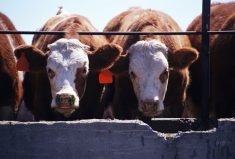Western Canadian feeder cattle prices traded steady to as much as $10 lower compared to week-ago levels. Feedlot hands are contending with adverse winter conditions and cattle travelling farther distances were down $6 to $12 in non-major feeding regions.
Feeder markets were slightly softer Monday through Wednesday; however, feedlot operators were quick to back away with live cattle futures sharply lower late in the week. There was no end to the negative economic news and beef demand moving forward is very uncertain. Calls coming in this week focused on consumer behaviour over the next few months because unhedged cattle remain in negative territory. Previous financial market meltdowns wreaked havoc on cattle producers and these memories are still fresh. Therefore, feedlot operators were not interested taking on more risk for now, so they outright put their hands in their pockets.
Read Also

U.S. livestock: Cattle futures end higher on cold weather, rising cash prices
Chicago | Reuters – Chicago Mercantile Exchange (CME) cattle futures closed higher on Thursday for the third straight session, as…
Charolais-cross medium-flesh mixed steers averaging 775 lbs. were quoted at $235 in central Alberta; black Angus-cross heifers averaging 710 lbs. traded just over $210 in the same region. Mixed steers averaging just over 600 lbs. were quoted in the range of $255-$260 in the Lethbridge area, while heifers were at a $20-$25 discount. The market was relatively even across the Prairies, with limited numbers on offer in Saskatchewan and Manitoba. Colder temperatures tempered sales volumes and U.S. feeder markets were also $5-$10 lower compared to last week.
U.S. wholesale choice beef was a bit softer at $230/cwt, but this is up sharply from December lows of $195. U.S. packers were more aggressive with purchases in Western Canada this past week, which helped clean up market-ready supplies. We’ve seen a resumption in beef demand as retailers dropped prices and featured beef products these past two weeks.
On the flipside, Canada is in a recession and the consumer-based U.S. economy may rein in spending on further equity market erosion. U.S. and Canadian consumers need to eat more beef this year, given the larger production estimates, so the economic environment isn’t conducive to higher beef prices.
— Jerry Klassen is manager of the Canadian office for Swiss-based grain trader GAP SA Grains and Produits. He is also president and founder of Resilient Capital, which specializes in proprietary commodity futures trading and commodity market analysis. Jerry owns farmland in Manitoba and Saskatchewan but grew up on a mixed farm/feedlot operation in southern Alberta, which keeps him close to the grassroots level of grain and cattle production. Jerry is a graduate of the University of Alberta. He can be reached at 204-504-8339.
















